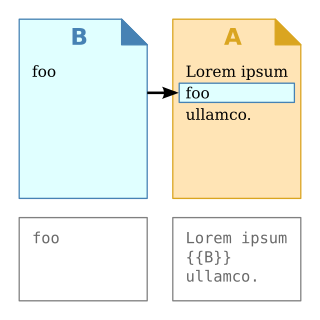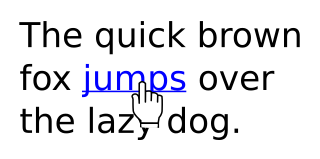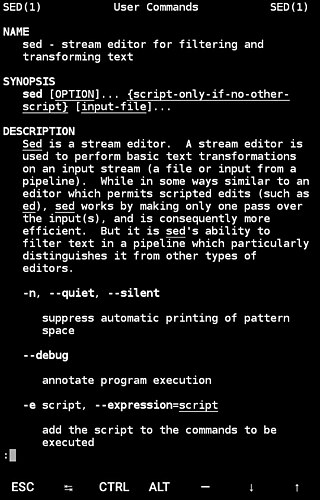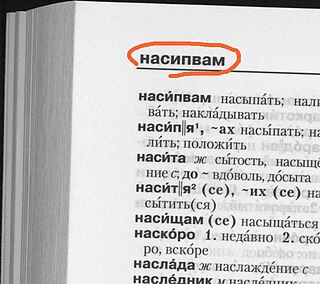
In computer science, transclusion is the inclusion of part or all of an electronic document into one or more other documents by reference via hypertext. Transclusion is usually performed when the referencing document is displayed, and is normally automatic and transparent to the end user. The result of transclusion is a single integrated document made of parts assembled dynamically from separate sources, possibly stored on different computers in disparate places.

A markuplanguage is a text-encoding system which specifies the structure and formatting of a document and potentially the relationships among its parts. Markup can control the display of a document or enrich its content to facilitate automated processing.

A signature block is a personalized block of text automatically appended at the bottom of an email message, Usenet article, or forum post.

In computing, a hyperlink, or simply a link, is a digital reference to data that the user can follow or be guided to by clicking or tapping. A hyperlink points to a whole document or to a specific element within a document. Hypertext is text with hyperlinks. The text that is linked from is known as anchor text. A software system that is used for viewing and creating hypertext is a hypertext system, and to create a hyperlink is to hyperlink. A user following hyperlinks is said to navigate or browse the hypertext.

A man page is a form of software documentation found on Unix and Unix-like operating systems. Topics covered include programs, system libraries, system calls, and sometimes local system details. The local host administrators can create and install manual pages associated with the specific host. A manual end user may invoke a documentation page by issuing the man command followed by the specific detail they require. These manual pages are typically requested by end users, programmers and administrators doing real time work but can also be formatted for printing.
e-text is a general term for any document that is read in digital form, and especially a document that is mainly text. For example, a computer-based book of art with minimal text, or a set of photographs or scans of pages, would not usually be called an "e-text". An e-text may be a binary or a plain text file, viewed with any open source or proprietary software. An e-text may have markup or other formatting information, or not. An e-text may be an electronic edition of a work originally composed or published in other media, or may be created in electronic form originally. The term is usually synonymous with e-book.

To publish is to make content available to the general public. While specific use of the term may vary among countries, it is usually applied to text, images, or other audio-visual content, including paper. Publication means the act of publishing, and also any copies issued for public distribution.
An HTML element is a type of HTML document component, one of several types of HTML nodes. The first used version of HTML was written by Tim Berners-Lee in 1993 and there have since been many versions of HTML. The current de facto standard is governed by the industry group WHATWG and is known as the HTML Living Standard.

Copy editing is the process of revising written material ("copy") to improve quality and readability, as well as ensuring that a text is free of errors in grammar, style, and accuracy. The Chicago Manual of Style states that manuscript editing encompasses "simple mechanical corrections through sentence-level interventions to substantial remedial work on literary style and clarity, disorganized passages, baggy prose, muddled tables and figures, and the like ". In the context of print publication, copy editing is done before typesetting and again before proofreading. Outside traditional book and journal publishing, the term "copy editing" is used more broadly, and is sometimes referred to as proofreading; the term sometimes encompasses additional tasks.
A work of the United States government is defined by the United States copyright law, as "a work prepared by an officer or employee of the United States Government as part of that person's official duties". Under section 105 of the Copyright Act of 1976, such works are not entitled to domestic copyright protection under U.S. law and are therefore in the public domain.
XSL-FO is a markup language for XML document formatting that is most often used to generate PDF files. XSL-FO is part of XSL, a set of W3C technologies designed for the transformation and formatting of XML data. The other parts of XSL are XSLT and XPath. Version 1.1 of XSL-FO was published in 2006.
URL redirection, also called URL forwarding, is a World Wide Web technique for making a web page available under more than one URL address. When a web browser attempts to open a URL that has been redirected, a page with a different URL is opened. Similarly, domain redirection or domain forwarding is when all pages in a URL domain are redirected to a different domain, as when wikipedia.com and wikipedia.net are automatically redirected to wikipedia.org.

In typography and word processing, a page header is text that is separated from the body text and appears at the top of a printed page. Word-processing programs usually allow for the configuration of page headers, which are typically identical throughout a work except in aspects such as page numbers.

In graphic design, page layout is the arrangement of visual elements on a page. It generally involves organizational principles of composition to achieve specific communication objectives.
In HTML, the standard markup language for documents designed to be displayed in a web browser, <div> and <span> tags are elements used to define parts of a document, so that they are identifiable when a unique classification is necessary. Where other HTML elements such as <p> (paragraph), <em> (emphasis), and so on, accurately represent the semantics of the content, the additional use of <span> and <div> tags leads to better accessibility for readers and easier maintainability for authors. Where no existing HTML element is applicable, <span> and <div> can valuably represent parts of a document so that HTML attributes such as class, id, lang, or dir can be applied.
HTML attributes are special words used inside the opening tag to control the element's behaviour. It is a piece of markup language used to adjust the behavior or display of an HTML element.HTML attributes are a modifier of a HTML element type. An attribute either modifies the default functionality of an element type or provides functionality to certain element types unable to function correctly without them. In HTML syntax, an attribute is added to a HTML start tag.
A canonical link element is an HTML element that helps webmasters prevent duplicate content issues in search engine optimization by specifying the "canonical" or "preferred" version of a web page. It is described in RFC 6596, which went live in April 2012.

In books and documents, a section is a subdivision, especially of a chapter.
jQuery Mobile is a touch-optimized web framework, specifically a JavaScript library, developed by the jQuery project team. The development focuses on creating a framework compatible with many smartphones and tablet computers, made necessary by the growing but heterogeneous tablet and smartphone market. The jQuery Mobile framework is consistent with other mobile app frameworks and platforms such as PhoneGap, Worklight, etc.
HTML5 Article is a HTML5 semantic element, similar to <section> and <header>. It is most commonly used to contain information that may be distributed independently from the rest of the site or application it appears in.











